KATHMANDU - VALLEY OF THE GODS
by Laurianne Classe, Africa EditorAt the zenith of the flower-power era in the early seventies, Kathmandu was the buzz-word of the traveling set, the ultimate destination if one was at all interested in self-fulfilment, peace, love and Eastern mysticism with a generous sprinkling of mind-expanding substances to speed one on one's way to full enlightenment.
The beaded and the bearded wanderers from Europe were dubbed "freaks" by the locals and today, a quarter of a century later, the notorious Freak Street remains, running off Kathmandu's Royal Square. Tamed by the years, it remains a pale shadow of its former self, although pockets of nostalgia hold out on the encroaching curio shops and handicrafts stalls. I unearthed a funky little cafe hunched under a low roof with fading turquoise walls and red Formica-topped tables. In the background, David Bowie crooned to the monochrome icons on the wall; Bob Dylan and Tina Turner, The Rolling Stones and the assembled pantheon of Sergeant Pepper's Lonely Hearts Club Band.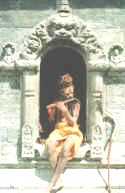
Images & Text © Laurianne Claase 1999-2007
This is recent history however. The labyrinthine alleys of the old city, teeming with beggars and bearers and zither-players, butcher shops and street corner barbers, tethered goats and ambling cows, suggest a world that has been caught in time like a fly in amber. To wander through these streets is to be propelled into a distant past - to a time when the Kathmandu Valley was a medieval settlement of city-states, each with their own king. Royal rivalry encouraged magnificent feats of architecture and palaces and temples, shrines and monuments decorate the valley in ornate profusion.
Durbar square, the ancient royal compound in the old heart of Kathmandu is a riotous feast of architectural styles and periods. A neo-classical facade of soaring marble is set incongruously alongside the distinctive Nepalese pagoda temples with their intricately carved wooden window-frames. Indian influence is evident in the corn-cob shikara-style shrines to Shiva and Krishna and in the erotic carvings which decorate the pagoda roof-struts. The architectural variety of Durbar Square reflects the enthusiastic religious borrowing that has helped shape Nepalese Buddhism. The mountain kingdom is sandwiched between India to the south and China to the north and thus the country's religion has absorbed elements of both Indian Hinduism and Chinese Buddhism, evolving into a unique religious hybrid. Tibet is another close neighbour and after the Chinese occupation of their homeland in the fifties, a large number of Tibetan refugees settled in Nepal adding their own special blend of Buddhism to the local religious stew. 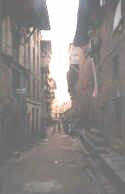
Indeed one of the most popular tourist poster images of Nepal is the Tibetan Buddhist temple of Swayambhunath which presides over a hilltop west of the city. Known locally as the "monkey temple" for its tribes of capering primates, the complex offers the visitor an opportunity to experience Tibetan culture within a unique Nepalese context. The happy mingling of different faiths is once again apparent as the hilltop compound houses not only the main Buddhist edifice but also a temple to the Hindu goddess of smallpox. I visited the site at sunset to be rewarded by light-dappled views of the fertile valley below while fledgling monks in comfortably grubby robes played at marbles in the fading light. As the boys played and the monkeys nonchalantly posed for photos, worshippers circled the base of the temple mound, setting in motion the ring of prayer 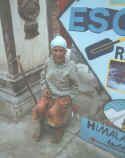 wheels and releasing a string of silent incantations into the evening sky.
wheels and releasing a string of silent incantations into the evening sky.
I met a Peruvian trader who professed bewilderment at the placid stoicism of the Nepalese who live in one of the poorest countries in the world. "These people," he said, " They are so poor and yet they just sit and wait for God." Understandable perhaps, as here in the highest region of the world, they are nearer to him than most.
Walking through the teeming alleys of the old city, religion hangs in the air with the tang of incense and the smoky scent of spices, the reek of excrement and rotting garbage. Despite their obvious impoverishment the people live and worship as they have for centuries, their crumbling dwellings clustered around a central courtyard which usually houses a shrine to a favourite deity. Handsome Nepali matrons in saris as vivid as the plumage of exotic birds, tiptoe through the roadside muck to make their devotions at a temple to the elephant god, Ganesh. A whirling dervish, seemingly in the throes of a divinely-inspired ecstasy, with flaming hair and grotesque mask, hurls himself down the street through the throngs of people and bicycle-rickshas. Hot on his heels race enthusiastic pursuers. Whether they are disciples or spectators is impossible to tell.
If the divine mysteries are cause for festivity so the commonplace certainties of life are also cause for celebration. Here, there is no Calvinist prudery about sex or modern squeamishness about death. The Nepalese celebrate both in graphic temple carvings like those I found in Patan - another of the erstwhile medieval city-states which today boasts the richest architectural inheritance of the kingdom. The wooden roof-struts of this particular temple revelled in depictions of numerous imaginative couplings, mutual masturbations and intricately entangled threesomes and included a faithfully rendered scene of a woman serenely being entered by a rearing horse. As I am marvelling at such inventiveness, one of the numerous touts who hover around the tourist sites waiting to swoop on the unwary makes his move. He's a boy of about ten and he knows full well what I'm looking at. "Nice eroteek"he remarks by way of conversation. He then proceeds to inform me of how, in days gone by, early marriages were the custom, couples as young as himself being wed. "They do not know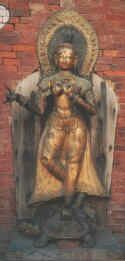 about sex, you see, so they can come here and find out." A novel alternative to that inevitable awkward discussion about the birds and the bees.
about sex, you see, so they can come here and find out." A novel alternative to that inevitable awkward discussion about the birds and the bees.
An adjacent temple illustrates in equally enthusiastic detail, the tortures inflicted upon the unfortunate souls of the damned. In one carving, a demon twists the tongue of his victim with a monkey wrench while another stands, club raised overhead, ready to offer assistance. Another poor fellow is shown threaded through a rack, his head lolling at an impossible angle and then there is the torturer, with over-sized mortar and pestle diligently grinding his victim into mincemeat.
One feels that life and art, architecture and religion has achieved a synthesis here that is sadly lacking in the West. In Nepal the commonly used greeting "namaste" means "I salute the god in you," and daily commerce takes place under the wood-carved gaze of deities and demons, elephant gods and buddhas, while holy cows root through the garbage in the gutters and a living goddess presides over the city.
She is a pre-pubescent girl chosen from among the ranks of the gold and silversmith caste and her reign as deity lasts until her first period when she resumes mortal status once more and is replaced by a new goddess. Thus the Nepalese and their gods of the roof of the world resist the encroachment of the impending millennium.
If the old city of Kathmandu is evocative of an earlier time then Bakhtapur, the third of the old city -states, is a community where time has stood still for centuries. There are no cars to remind one of the twentieth century and once one alights from the bus and steps into the cobbled lanes and shadowed courtyards, it is easy to imagine oneself a time-traveller to a remote medieval past.
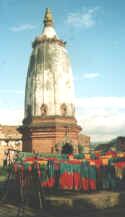
Everywhere there is a colourful assault upon the eye amidst the age-worn browns of cobble and wood. The vivid scarlet of chillies laid out to dry; the sun-warmed yellow of corn sheaves and shallots hanging from tenement windows; the distinctive black and red saris of the Newari women. Around the stagnant water of a large, sunken pool, the dyers hang their coloured yarns to dry in brilliant swatches of yellow and red and purple and indigo - the alleys run blue with dye. Little boys with shaven heads and top knots fly parti-coloured kites borne aloft by the cloudy breath of mountain breezes.
In the closing days of the present century, with the information highway straddling the globe, few areas remain untouched by prevailing western values. Cultural diversity is being replaced by a banal uniformity inspired by that popular trinity of Western household gods - Money, Mickey Mouse and Macdonalds. But in a world increasingly saturated with the smell of Big Macs frying, Nepal is a breath of fresh mountain air.
